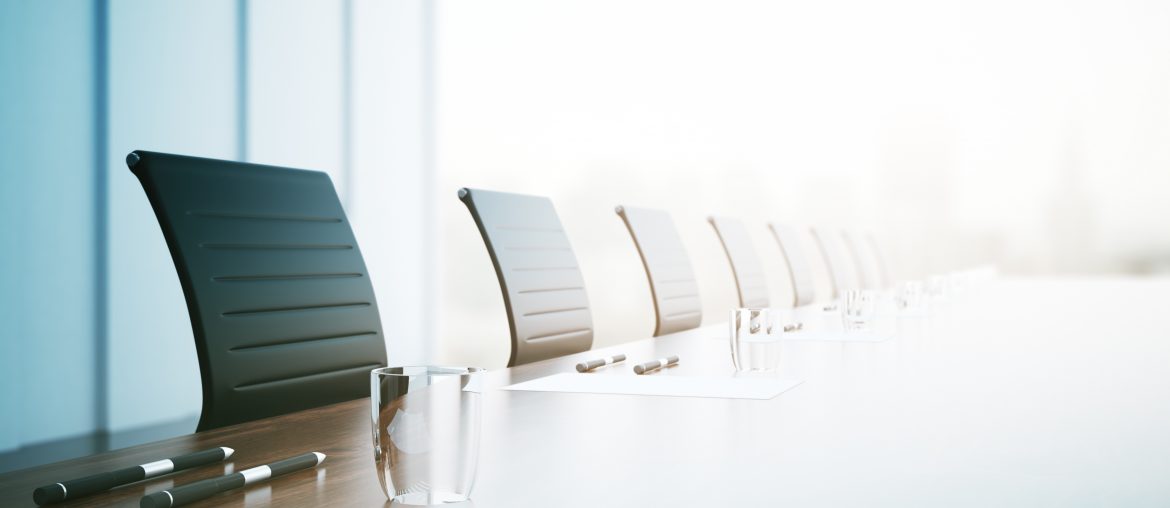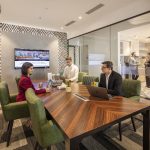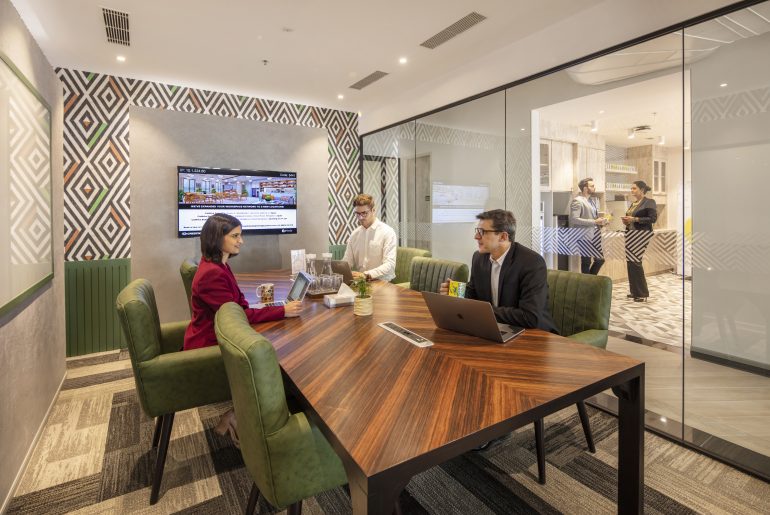Meeting rooms constitute an important component of a workspace. Several pieces of research have shown that teams across organisations are spending more time in meeting rooms. These are spaces where creativity flows, discussions are brought to fruition and key decisions are taken. As such, meeting spaces should be designed to support the kind of interactions that take place inside.
However, meeting rooms are also something that is often ignored in terms of design. Meeting room design can have a significant impact on the outcome of the discussion. Design elements such as the type and placement of furniture, conferencing equipment, lighting, acoustics and room decor play an important role in the direction a meeting can go. Yet, most meeting room designs seen today fail to support the types of conversations that take place inside. Here’s why:
Uniform room size
A workspace environment usually witnesses different types of interactions on a regular basis, from 1-on-1 meetings and a quick stand-up meeting to a full-fledged client presentation. Hence, meeting rooms should be designed to match the different types of requirements. However, the problem workspaces often face is that meeting and conference rooms are of uniform size and do not support different types of interactions.
Oversized and underutilised rooms
Another problem workspaces often witness is that a significant portion of their meeting rooms are empty even during a meeting. According to data collected by CBRE, JLL, and Density, a people count sensor platform, only 40% of meeting rooms are occupied when a meeting is in progress. The percentage of participants who occupy larger rooms in a week falls further. For example, Density witnessed that the larger meeting rooms were occupied by only seven people for only 2% of the workday.
This creates a problem of suboptimal utilization of meeting rooms. Another problem it creates is that when a smaller team utilises a large meeting room, a team that actually needs a larger space will be left searching for one.
Faulty technology
Imagine that your meeting is about to begin and you are unable to connect your device to the projector or the internet connection stops in the middle of a conference. The time it takes for you to fix the problem is a loss of your productive time. Multiply this time with the number of participants waiting for the meeting to begin or continue. This is a significant loss of everybody’s valuable time.
Technology failure is a common problem that often plagues meeting and conference rooms. Some of the common technical problems involve poor wi-fi connections, faulty projections or display systems, stilted conference calls and presentations, and incompatible technology that make participants unable to connect their devices.
Another challenge many organisations often face is the lack of technology for booking meeting rooms which often leads to problems such as double bookings and no-show meetings. Without a proper booking system, teams find it difficult to know if a meeting space is available or not. According to a Steelcase Workplace Survey, about 40% of employees waste up to 30 minutes a day or 3.5 hours a week looking for an empty meeting room. This means that the lack of a proper meeting room booking system can affect employee productivity.
No-show meetings can additionally lead to wastage of meeting room resources such as electricity, wi-fi, and conferencing tech.
Outdated designs
Another common problem associated with conference and meeting rooms is poor and outdated designs. Poor design can range from improper lighting and wrong acoustics to wrong screen size and uncomfortable furniture. For example, according to a study by the American Society of Interior Design, about 68% of the people complain about the lighting in their offices.
Similarly, a 2016 study by Gensler shows that three people sitting in a mid-sized conference room can generate an ability-limiting level of CO2 within one hour. This means that lack of sufficient ventilation can stifle the discussions in a meeting room.
How modern meeting and conference rooms should be designed
Design spaces according to the purpose
Before adding a meeting room, it is important to know the different purposes a meeting space can be used for. Spaces should be designed and built to match the different sizes of groups and types of interactions that commonly take place. Additionally, meeting room analytics and utilization data can be employed in gaining a fair understanding of the right mix of sizes and types of meeting rooms to be added.
It is a good idea to experiment with modular room designs. This helps in scaling up or down the meeting space depending on the need without hampering the meeting room experience.
Design for comfort
Everything you design for a meeting room should spell comfort be it lighting, air, acoustics, furniture or movement space. Sufficient care must be taken when installing the lighting and sound fixtures as well as ventilation in the room. For example, the light, air conditioning, and chairs should be comfortable enough so that people can focus on the discussion instead of getting distracted by the uncomfortable ambiance. Even if discussions extend beyond a certain duration, people should feel comfortable enough to sit for a longer time.
Similarly, acoustics should be designed such that there is no sound echo, reverberation, or feedback between speakers and microphones. For rooms without windows, sufficient light must be provided while for rooms with too much natural light, blinds may have to be used to reduce light.
Employ user-friendly technology
While selecting a meeting room equipment such as a video conferencing device, know the purpose of the room. While a room designed for a quick huddle may only need a whiteboard, marker, and a duster, a boardroom may need an advanced teleconferencing facility.
Furthermore, meeting room technology must be user-friendly. For example, when users plug-in their device, they must be able to use it without hassles. The technology should further enable participants to share their screens and content seamlessly with other participants from a device of their choice. There are quite a few conferencing platforms that make it easy for participants to use their device to share audio, video, and data with other participants.
Technology should also be extended to meeting room bookings. Using a good booking system and ensuring the meeting room users follow the best practices of booking helps in utilising the rooms more efficiently and improves employee productivity.
Be creative
A person can instinctively feel comfortable or cautious as soon he/she enters a meeting or conference room. This depends significantly on the atmosphere the room projects. A meeting room design goes beyond the placement of the furniture or the equipment. The meeting or conference room should exude an atmosphere that is comfortable for a participant. To make this possible, there are certain design principles that should be taken into consideration.
Some of them include:
- Emotions and feelings: Consider what emotions and feelings you want to evoke in your participants. Design elements such as visuals, seating arrangement, colour, lighting, and music should be chosen according to these feelings.
- Theme and identity: A good integration between the meeting room and brand themes instills a sense of familiarity and belongingness in the participants. Brand colours, slogans, and logo play an important role in infusing this feeling.
- Lines and shapes: Lines and shapes are important to set the mood of the space. Soft lines and circular shapes often create a sense of comfort and openness.
Once you have fulfilled the hard requirements of the meeting room, you can get creative with the interiors. However, ensure that the designs focus on enhancing the productivity of the rooms instead of distracting the participants. Choose carpets, furniture and colour schemes that reflect your corporate culture while providing the necessary impetus for the meeting room goals.
For example, if you are choosing a colour template, use your company colours to enhance the meeting room experience. For more formal conference rooms and boardrooms, choose neutral colours. Similarly, glass and chrome provide a modern and clean look to your meeting room.
In closing
Meeting spaces are more than what meets the eye. They are where productive interactions happen. Meeting room design can impact the way meetings are conducted and the direction they take. Following modern design techniques can help achieve the most out of the interactions that take place in these spaces.
Looking for a meeting or a conference room that suits your needs? Click here.







